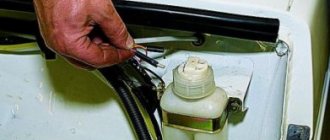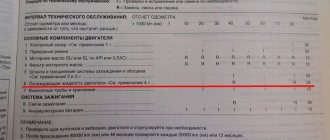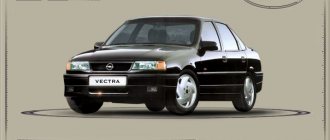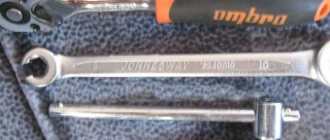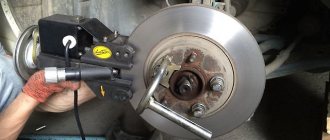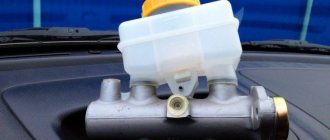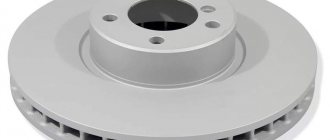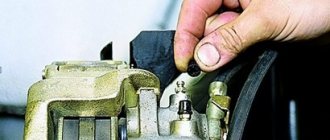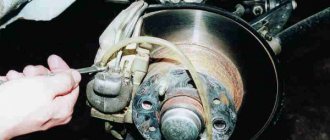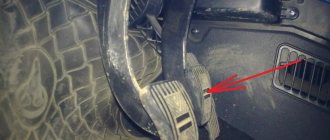Did you like the article? Follow our channel for new ideas of useful car tips. Subscribe to us in Yandex.Zen. Subscribe.
A malfunction of the brake system can be judged by various manifestations. It is important to notice and correct problems in time. Read on to learn more about signs of brake problems.
External signs of a brake system malfunction
An attentive driver immediately notices changes in the car's behavior. According to the method of manifestation, they can be divided into groups:
- abnormal behavior of the brake pedal;
- the appearance of unusual sounds;
- traces of brake fluid leakage;
- changes in braking speed and vehicle movement;
- the appearance of steering wheel vibration.
Any of these signs is cause for concern.
Brake pedal
A low brake pedal indicates jamming of the automatic distribution of brake linings or pads, their severe wear, and loss of brake fluid. Often accompanied by strong heating of the wheel rim and a burning smell. Faulty parts should be checked and replaced. A hard pedal stroke or complete immobility is a symptom of a broken brake booster. In models with a vacuum booster, you should look at the condition of the hose, control valve, and the presence of a discharged medium in the intake manifold.
The hydraulic booster does not work due to wear on the drive belt and lack of fluid in the system. The amplifier itself may be damaged. A sign of problems in the operation of the brake cylinders and air in the hydraulic system is the failure of the brake pedal. A breakdown of the brake master cylinder, air entering the line, and insufficient brake fluid volume is manifested by low braking speed and unnaturally soft pedal movement.
A grinding sound indicates friction between the pad and the disc. Eliminated by replacing worn parts. Whistling or squealing sounds from high-frequency vibration of the caliper and pads. It is repaired by boring and polishing the discs or replacing them, cleaning, lubricating the caliper, and replacing defective pads.
Loss of brake fluid
If the liquid in the tank drops below the required level, it is leaking somewhere. You should look at the area under the car; there may be puddles of liquid there. If the cylinders are leaking, marks will appear on the wheels. A serious signal to check the condition of hoses and tubes. A part with smudges must be replaced as faulty.
Braking speed and straightness
Loss of brake fluid, deep scratches on wheel rims, lubrication on the working surface of the pads results in uneven and slow braking. Eliminated by repairing the source of the leak, replacing defective pads. When the car changes direction and, while braking, deviates from the course, you need to check the brake adjustment, oiling, contamination of the pads, and the operation of the system cylinders. This behavior of the car may also indicate different wear on the pads and discs of the front wheels.
Parking brake lever
If, when the handbrake is raised, the car slides off an inclined area, or for its operation it is necessary to pull it forcefully, this is a bad sign. Ignoring or delaying problems in the brake system is the same as playing with fire. Therefore, if any of the described signs appear, you should immediately visit a car service center.
Vacuum brake booster
An excellent device that helps relieve unnecessary effort when braking, but sometimes the vacuum diaphragm can cause trouble if it is neglected or the service life is exceeded. The symptoms are simple and clear. The pedal began to sink to the floor, but the fluid does not leave when the engine is running, while the brakes are elastic when the engine is turned off.
The reason is that the air brake booster only starts working when the engine is running. If the diaphragm is worn out or ruptured, vacuum in the vacuum booster chamber cannot be achieved. In this case, the pedal will fall when starting the engine. But there is one thing. For vacuum boosters designed by VAZ 2105, VAZ 2107, the following picture is completely normal: we press the brake pedal with the engine off, then we start the engine and the pedal moves a few millimeters forward, becoming a little softer. This is a sign of normal operation of the vacuum booster.
Causes of air in the brake system
Despite the fact that the effect of “airing” the brake system is difficult to diagnose in a garage, we can nevertheless identify several key reasons for its occurrence:
- Reducing the amount of brake fluid leads to air “trapping”. It is necessary to regularly check the volume of brake fluid in the reservoir in order to notice a problem in time.
- Sealing collars in brake cylinders, like all parts, are prone to wear. Failure of these elements can also lead to the appearance of air in the brake system.
- The service life of brake pipes and hoses is on average 4 years, so if your car has been in use for several years, it is worth checking these elements for wear to avoid loss of system tightness.
- Metal brake pipes are subject not only to natural wear and tear, but also to corrosion. It is also necessary to periodically check their condition.
- Often a marker of a problem in the brake system and loss of its tightness is the appearance of characteristic leaks. If you encounter a brake fluid leak, you must postpone driving the car until the problem is fixed.
- Brake fluid is hygroscopic, meaning it tends to accumulate moisture. This process is characterized by the loss of properties of the brake fluid. Visually, this can be determined by a change in its color, which becomes darker. Please note that brake fluid should be changed every 2 years or according to the car manufacturer's instructions. It is highly not recommended to use the used brake fluid any further, since during the braking process the old brake fluid heats up and boils, as a result of which air bubbles form and the brake system becomes airy.
As we can see, the appearance of air is one of the main enemies of the braking system, so it is necessary to constantly monitor the condition of its elements. If you encounter air in the brake system, you need to bleed the brakes, which we describe in detail in the article “How to bleed the brakes on a car.”
You can purchase spare parts and elements of the brake system on favorable terms in the IXORA store, where you are guaranteed to have excellent prices, a wide range of products for any make of car, as well as a free selection of parts by an expert.
| Manufacturer | Detail number | Part name | Applicability* |
| BREMBO | P56046 | Brake pads Brembo, INFINITI, NISSAN, RENAULT, SUZUKI | INFINITI FX, G, M35, M45, NISSAN Altima, Cube, Dualis, Elgrand, Maxima, Murano, Qashquai, Serena, Teana, Tiida, Versa, X-Trail, RENAULT Koleos, SUZUKI Landy |
| BREMBO | P24061 | Brake pads Brembo, FORD, MAZDA, VOLVO | FORD C-Max, Ecosport, Escape, Focus, Grand, Kuga, MAZDA 3, 5, Axela, Premacy, VOLVO C30, C70, S40, V40, V50 |
| BREMBO | P85072 | Brake pads Brembo, AUDI, SEAT, SKODA, VW | AUDI A2, A3, SEAT Altea, Ibiza, Leon, Toledo, SKODA Citigo, Fabia, Laura, Octavia, Praktik, Roomster, Yeti, VW Beetle, Bora, Caddy, Derby, Golf, Jetta, New, Novo, Polo, Rabbit, Up, Vento |
| BREMBO | P78013 | Brembo brake pads, front, SUBARU | SUBARU BRZ, Forester, Impreza, Lagcy, Liberty, Outback |
| BREMBO | P83066 | Brake pads Brembo, LEXUS, MITSUBISHI, TOYOTA | LEXUS GX, MITSUBISHI Montero, Pajero, Shogun, TOYOTA 4, FJ, Fortuner, Hilux, Land, SW4, Tacoma, Tundra |
| BREMBO | P83024 | Brembo brake pads, front, LEXUS, MITSUBISHI, TOYOTA | LEXUS GX, MITSUBISHI Montero, Pajero, Shogun, TOYOTA Prado |
| KASHIYAMA | D6108 | Brake pads KASHIYAMA, front, MITSUBISHI | MITSUBISHI Lancer, Outlander |
| KASHIYAMA | D1261 | Brake pads KASHIYAMA, front, LADA, NISSAN, RENAULT, SUZUKI | LADA Largus without ABS, NISSAN Almera, RENAULT Duster, SUZUKI Swift III 05- |
| KASHIYAMA | D6124 | Brake pads KASHIYAMA, rear, MITSUBISHI | MITSUBISHI Lancer, Outlander |
| KASHIYAMA | D1244M | Brake pads KASHIYAMA, rear, NISSAN | NISSAN Murano, Qashquai, Tiida |
| KASHIYAMA | D6039M | Brake pads KASHIYAMA, front, MITSUBISHI | MITSUBISHI Outlander, Outlander XL, Space Wagon |
| KASHIYAMA | D1276 | Brake pads KASHIYAMA, front, NISSAN | NISSAN X-Trail, Qashquai |
| KASHIYAMA | D2268 | Brake pads KASHIYAMA, front, TOYOTA | TOYOTA RAV-4 06- |
| KASHIYAMA | D2270 | Brake pads KASHIYAMA, front, TOYOTA | TOYOTA Camry 06- |
| KASHIYAMA | D6128M | Brake pads KASHIYAMA, front, MITSUBISHI | MITSUBISHI L200 2.5DI-D 05- |
| NIBK | PN0537 | Brake pads NIBK, front, KIA | KIA RIO III 11-12- |
| NIBK | PN0538 | Brake pads NIBK, rear, HYUNDAI, KIA | HYUNDAI Solaris 10-, I30 11- 13-, I40 11-, KIA RIO 11- 12-, Ceed 12- 13-, Optima 2.0 12- |
| NIBK | PN3233 | Brake pads NIBK, CITROEN, MITSUBISHI, PEUGEOT | CITROEN C-Crosser, MITSUBISHI 3000, AirTrek, Aspire, Sedia, Challenger, Colt/Rodeo, Delica, Eclipse, Eterna, FTO, Galant, Grandis, GTO, G-Wagon, Lm Lancer, Legnum, Libero, Magna, Mighty, Montero , Nimbus, Outlander, Pajero, PHEV, Shogun, Sigma, Space, Strada, Triton, Verada, PEUGEOT 4007 |
| NIBK | PN1243 | Brake pads NIBK, rear, TOYOTA | TOYOTA 4runner 04-08, Hilux 02-05, Land Cruiser 90-04 |
| NIBK | PN0436 | Brake pads NIBK, rear, HYUNDAI | HYUNDAI Accent 1.4/1.6L 05-, Accent usa 1.4/1.6L 06-, i30 1.4/1.6/2 |
Brake system design
First, let us briefly recall the structure of the hydraulic brake system, the principle of its operation and the most vulnerable components on the most common car models. A closed volume and the incompressible fluid contained in it is the basic principle of operation of all hydraulic systems, including brake systems. This is not the only type of braking system. It used to be used, and even now you can find a mechanical drive on some prehistoric cars. It is more reliable than hydraulics, but does not have such elasticity and is too dependent on mechanical wear of rods, cables and their connections, and has low efficiency. The air brake system is used only on trucks and buses. It is too bulky for a passenger car, although it is not inferior in efficiency to hydraulics.
The hydraulic brake system consists of a master cylinder, hydraulic line, brake wheel cylinders, compensating device and brake pads and discs. The force from pressing the brake pedal is transmitted to the master cylinder filled with brake fluid. The master cylinder piston presses on the fluid, which transmits force to the wheel brake cylinders.
Video tutorial about the design of the car brake system
https://youtube.com/watch?v=6-1y6jJPWWU
They force the brake pads to compress the brake discs or drums, and at maximum force, they completely lock them. The operating principle of hydraulics ensures uniform and smooth action on the brake discs, and the force applied to the pedal is directly proportional to the compression force of the brake pads. When we release the pedal, the return springs of the brake pads return them to their original place, the fluid is forced into the master cylinder and the system waits for further orders.
But there are a lot of devices that we will mention in the future: brake booster, braking force compensator, the anti-lock braking system also has its influence, which also cannot be ignored
Helpful information:
You can get professional advice when selecting a product by calling 8 (calls within Russia are free).
Operating a vehicle with a faulty brake system is prohibited. Therefore, every motorist should know the main malfunctions of the brake system and identify them by external signs.
This article discusses the main malfunctions of the hydraulic service brake system of a passenger car.
In order not to experience a sudden brake failure, you need to at least have a general idea of the most common symptoms of brake system problems, their causes and possible consequences.
The following list of typical faults and their causes is not exhaustive. Each problem of the brake system requires qualified diagnostics and repairs, carried out in a car service center in Nagorny by specially trained personnel.
1) Low brake fluid level. May be caused by excessive brake pad wear, but in many cases is associated with brake fluid leaking from the system and is therefore a serious hazard. The brake wheel cylinders, calipers, brake hoses and pipes, and the brake master cylinder must be carefully inspected for fluid leaks. A failed part must be replaced. The vehicle cannot be operated until the fault is completely eliminated.
2) Low brake pedal. Appears when the automatic drum brake adjustment system, which is responsible for routing the brake pads as they wear out, is jammed. By manually adjusting the system, you can restore normal pedal travel, but the problem will reappear as the pads wear further. To completely eliminate the malfunction, it is necessary to clean or replace the automatic adjustment system. It may also be due to excessive brake pad wear or brake fluid leakage. 3) The brake pedal is too soft, low braking efficiency. Appears when air appears in the brake system as a result of its depressurization or incomplete pumping, as well as air entering from the expansion tank when the brake fluid level is low. It may also be a consequence of a malfunction of the master brake cylinder or jamming and overheating of the working cylinder, leading to boiling of the liquid in it. 4) Long brake pedal travel. Possible causes include worn brake pads, improperly adjusted drum brakes, and air in the system. The symptom carries a potential danger, since the pedal may fall to the floor at any time, or in a difficult road situation the braking may not be effective enough. 5) The brake pedal falls to the floor. An extremely dangerous situation caused by wear of any of the brake cylinders or depressurization of the hydraulic system. 6) Pulsation of the brake pedal or vibration of the car when braking. Not to be confused with pedal pulsation caused by ABS when a wheel is locked. The symptom indicates severe wear and deformation of the brake disc, a crack or a violation of the parallelism of the working surfaces. This cause can be eliminated by replacing or boring the worn disk. Don't forget to check the wear and tightness of the hub bearings, as well as the presence of grease in them. In many cases, failure of these bearings results in a pulsating brake pedal. 7) Grinding sound. Usually it is a consequence of friction of a pad worn to the metal on the brake disc. In most cases, in addition to replacing the pads, it is necessary to bore the working surface of the disc or replace it.  Squealing or whistling noise when braking. Caused by high-frequency vibration of brake pads and calipers. It can be eliminated by replacing or boring the brake discs and then polishing them. It can also be caused by the use of low-quality brake pads, so in many cases it is enough just to change the pads or clean the caliper and apply a special one. lubricant 9) Uneven or low braking performance. May be caused by grease or brake fluid getting on the working surface of the pad. To eliminate it, you need to find and eliminate the leak, then replace the brake pads. The presence of deep scratches on the working surfaces of brake discs or drums also leads to unevenness and reduced braking efficiency. In this case, they will need to be bored or replaced. 10) The car pulls to the side when braking. The symptom indicates contamination or oiling of any of the brake pads, poorly adjusted brakes, or failure of any of the brake wheel cylinders. It can also be caused by uneven wear of the front pads or brake discs, or by differences in the friction properties of the brake system parts of the right and left wheels. 11) The brake pedal is too hard. The occurrence of such a symptom indicates a malfunction of the brake booster. In cars equipped with a vacuum booster, the reason lies in a vacuum leak in the intake manifold, a malfunction of the vacuum hose, the booster itself or its control valve. Checking the serviceability of the vacuum booster is very simple. Check the tightness of all vacuum connections coming from the intake manifold. Start the engine to create a vacuum in the system. Step on the brake. A hard pedal indicates a faulty amplifier or vacuum hose. Then turn off the engine and wait 5 minutes without pressing the brake pedal. Now try pressing the pedal. If the pedal becomes hard the first time you press it, the control valve of the vacuum booster is faulty, violating the tightness of the system. There is another way to check the amplifier. With the engine off, press the brake pedal several times to release any vacuum that has built up in the system. The pedal will become hard. Now, without releasing the brake pedal, start the engine. With a working amplifier, the pedal will become much lighter and will go down a little. If this does not happen, and a vacuum leak from the intake manifold and a hose malfunction are excluded, the amplifier is faulty. On vehicles equipped with a hydraulic brake booster, a hard brake pedal may be the result of a worn power steering drive belt, a low level of fluid in the system (not to be confused with brake fluid), or a leak. In the rarest cases, the hydraulic booster itself is faulty.
Squealing or whistling noise when braking. Caused by high-frequency vibration of brake pads and calipers. It can be eliminated by replacing or boring the brake discs and then polishing them. It can also be caused by the use of low-quality brake pads, so in many cases it is enough just to change the pads or clean the caliper and apply a special one. lubricant 9) Uneven or low braking performance. May be caused by grease or brake fluid getting on the working surface of the pad. To eliminate it, you need to find and eliminate the leak, then replace the brake pads. The presence of deep scratches on the working surfaces of brake discs or drums also leads to unevenness and reduced braking efficiency. In this case, they will need to be bored or replaced. 10) The car pulls to the side when braking. The symptom indicates contamination or oiling of any of the brake pads, poorly adjusted brakes, or failure of any of the brake wheel cylinders. It can also be caused by uneven wear of the front pads or brake discs, or by differences in the friction properties of the brake system parts of the right and left wheels. 11) The brake pedal is too hard. The occurrence of such a symptom indicates a malfunction of the brake booster. In cars equipped with a vacuum booster, the reason lies in a vacuum leak in the intake manifold, a malfunction of the vacuum hose, the booster itself or its control valve. Checking the serviceability of the vacuum booster is very simple. Check the tightness of all vacuum connections coming from the intake manifold. Start the engine to create a vacuum in the system. Step on the brake. A hard pedal indicates a faulty amplifier or vacuum hose. Then turn off the engine and wait 5 minutes without pressing the brake pedal. Now try pressing the pedal. If the pedal becomes hard the first time you press it, the control valve of the vacuum booster is faulty, violating the tightness of the system. There is another way to check the amplifier. With the engine off, press the brake pedal several times to release any vacuum that has built up in the system. The pedal will become hard. Now, without releasing the brake pedal, start the engine. With a working amplifier, the pedal will become much lighter and will go down a little. If this does not happen, and a vacuum leak from the intake manifold and a hose malfunction are excluded, the amplifier is faulty. On vehicles equipped with a hydraulic brake booster, a hard brake pedal may be the result of a worn power steering drive belt, a low level of fluid in the system (not to be confused with brake fluid), or a leak. In the rarest cases, the hydraulic booster itself is faulty.
basic information
The main function of braking is to control the speed of the car, stop it, and also hold it in one position using the braking force between the road and the wheels of the car. The braking force can be generated by a car engine, a car wheel braking mechanism, or an electronic or hydraulic retardant brake located in the transmission. To enable all of the above functions, various types of braking systems are installed on the vehicle.
Consequently, the question arises, how much and in total?
- Working. This type is used at any speed of the machine to completely stop or reduce speed. Moreover, it begins to function immediately after pressing the brake pedal. It is considered the most effective compared to other types.
- Spare. Used when the main braking unit is faulty. This type of brake unit can be of two types, autonomous or its functions are performed as part of the working braking system.
- Parking lot. It is necessary to keep the machine in place for a certain time. That is, thanks to it, the possibility of the car moving without the driver’s knowledge is completely eliminated.
- Additional. Used on vehicles that have increased weight to stop on slopes. Quite often it happens that its stopping functions are performed by a motor on which the pipeline is closed using a damper.
What is the operating principle?
Let's look at the principle of braking using the example of a hydraulic operating unit. When the brake is pressed, the load is transferred to the amplifier, which creates additional reinforcement on the main cylinder. The piston of the main brake cylinder collects all the fluid in the car wheel cylinders using pipelines. Moreover, at the same moment, the fluid pressure in the brake drive increases. Thanks to the pistons of the car wheel cylinders, the brake pads move to the discs, or as they are also called drums.
After pressing the brake, the fluid pressure increases, as a result of which the braking mechanisms are activated, causing the rotation of the car wheels to slow down and generate braking force at the point of contact of the car tires with the road surface. Moreover, the more force is applied to the brake pedal, the more efficiently and quickly the car wheels will brake. The liquid pressure at the moment of stopping can reach from ten to fifteen megapascals.
Parts of the springs are retracted from the drums using blocks. Brake fluid passes into the main braking cylinder from the car wheel cylinders thanks to pipelines. Thus, the pressure of the braking system decreases. Braking performance is greatly enhanced by the use of vehicle safety systems.
Basic faults
The main task of diagnostics is to detect malfunctions in the brake system, as well as eliminate them with minimal use of money. In addition, timely detection of braking faults will allow you to avoid large expenses, because you can prevent breakdowns. In specialized centers, brake system diagnostics are carried out on a special stand, but you can do it yourself at home. To identify faults, you need to pay close attention to your vehicle.
https://youtube.com/watch?v=Av-jj8NNrv8
So how many brake system faults are there?
- The occurrence of extraneous noise;
- A creaking noise is heard when the vehicle is braking;
- There is noticeable leakage of brake fluid;
- The brake pedal gets stuck;
- The braking distance has increased noticeably.
As a rule, all of the above breakdowns of the braking system are associated with the following reasons:
- The tightness has broken;
- Low fluid level;
- Irregular fluid changes;
- The brake pads are badly worn.
Most often, the cause of problems is untimely replacement of the fluid, and this can lead to complete brake failure. It needs to be washed regularly due to the fact that at the time of use it absorbs all the moisture. There may also be an insufficient level of fluid in the braking system, as it evaporates during boiling, which occurs when the vehicle is braking.

